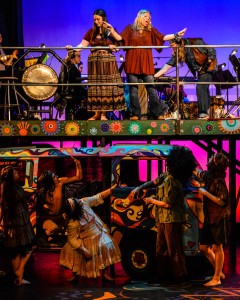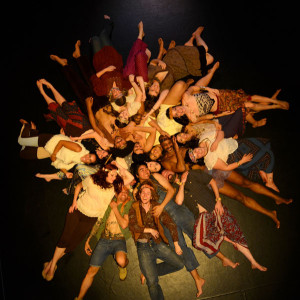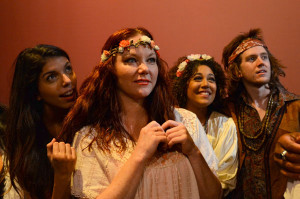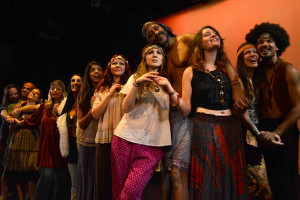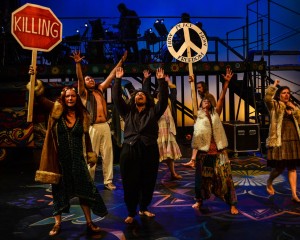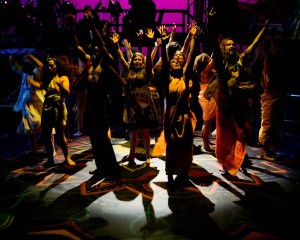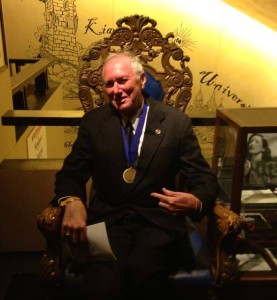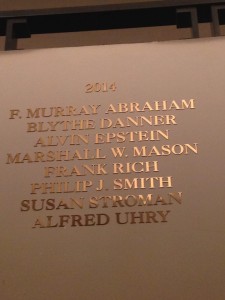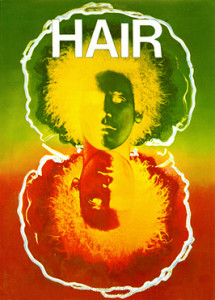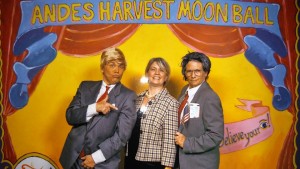 Each year the family tries to top itself at this popular Halloween costume contest in the Catskill Mountain town of Andes, New York. This year was no exception. Here are your “Best Group” winners, The Presidential Candidates, from left to right: Donald Trump (Jayne Anne), Hillary Clinton (Mary Lou) and Jeb Bush (Eloise). Wow!
Each year the family tries to top itself at this popular Halloween costume contest in the Catskill Mountain town of Andes, New York. This year was no exception. Here are your “Best Group” winners, The Presidential Candidates, from left to right: Donald Trump (Jayne Anne), Hillary Clinton (Mary Lou) and Jeb Bush (Eloise). Wow!
Author Archives: michael
A stunning new “HAIR” opens at Bainbridge Performing Arts, Washington State
This weekend, a new production of HAIR opened at Bainbridge Performing Arts, just a ferry ride away from my home in Seattle. Michael Moore, theater critic for The Kitsap Sun, was won over by the energy and vibrancy of the cast, the fine work of the creative team, and by the irresistible theatrical alchemy of HAIR. Here is his review, in PDF:
https://cdn.shopify.com/s/files/1/0152/6355/files/Review_-_Kitsap_Sun.pdf?16823330995522112269
If you live near Seattle, this is a HAIR you should see. Its anti-war message is as relevant today as it was almost 50 years ago. But don’t procrastinate – its three-week run ends Sunday, October 25. Below are director Teresa Thurman’s excellent program notes, and photos shared with me by BPA’s public relations director, Sally Jo Martine.
DIRECTOR’S NOTES by Teresa Thuman
What happens when two opposing forces collide, such as when a writer of college musical revues (James Rado) meets an experimental ritualistic theatre artist of the Open Theatre (Gerome Ragni) in the middle of an era of radical social change (1960’s)? You get the cosmic explosion and unique cultural fusion that is HAIR, the Broadway hit musical. HAIR was honest, raw, organic, iconoclastic, non-linear, and spoke to a generation rejecting their parents’ rigid and conventional social norms.
HAIR is primarily an anti-war story, created at a time of unapologetic experimentation with every conceivable means of altering reality: psychedelic drugs, sexual freedom, revolutionary politics, a search for identity, self-examination, and, under the shadow of potential induction into the draft, questioning existence itself. Within this environment, a brave, intimate and idealistic tribe is forged, and tested, on their path to celebrate the gift of life.
HAIR is now almost 50 years old, and in 2015 our concepts of radicalism have changed. The pendulum of social change swings through the decades, and HAIR now holds outdated views of racial equity, cultural and gender identity, sexual orientation, politics and drugs (addiction is never explored). We look back knowing much of this hippie utopia was naïve and unsustainable. However, I am forever grateful to this vanguard of courageous idealists, because without their radical acts in the 1960s, this world would be a very different place. Perhaps the Age of Aquarius is indeed upon us and the endurance of this musical is proof enough for me.
***
Rave review for Magie Dominic’s “STREET ANGEL”
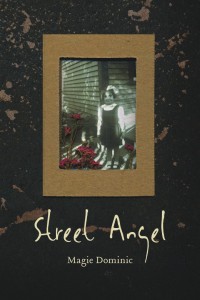 This year our good friend Magie Dominic published “Street Angel”, a memoir of her native Newfoundland.
This year our good friend Magie Dominic published “Street Angel”, a memoir of her native Newfoundland.
This quote is from a recent rave in The Antigonish Review:
“….Dominic writes as Julius Caesar spoke (“I came, I saw, I conquered.”), as Dickens wrote, and as Toni Morrison writes. The style is immediate and emotive. It also makes for a fasten-your-seat-belt read….”
And here’s the link to the full review by Marjorie Simmins:
http://www.antigonishreview.com/index.php?option=com_content&view=article&id=580
Get to know Magie by ordering “STREET ANGEL” and by visiting:
www.magiedominic.blogspot.com
Magie Dominic at Lincoln Center Archives
twitter @magiedominic
A smash hit in Albuquerque – “ANGELS OF LIGHT – The Practically True Story of The Cockettes”
Only three more performances remaining – hurry, hurry to Albuquerque before they sell out! Our cousin Dale Rose and her family caught the show this weekend and were quite moved by it. Here’s a local review:

TALKIN’ BROADWAY
Albuquerque
Regional Reviews
ANGELS OF LIGHT REVIEW BY DEAN YANNIAS
Angels of Light: The Practically True Story of The Cockettes
The Dolls at Aux Dog Theatre Nob Hill
If you were lucky enough to have been at the opening weekend of Angels of Light: The Practically True Story of The Cockettes, you would have had the privilege of hearing Rumi Missabu, one of the few surviving members of The Cockettes, sing “Stranger in Paradise” from Kismet half in the voice of Alfalfa and half in the voice of Marlene Dietrich, in drag. It’s this kind of absurdist creativity (genius, in a way) that was the hallmark of The Cockettes.
The Cockettes flourished for only a few years, 1969 to 1972, and were sui generis. They are usually called a psychedelic drag troupe, but their fantastic costumes and glittery makeup owe more to Mardi Gras parades than to traditional drag, and there were a few women in the group. They lived communally in San Francisco and performed almost exclusively there, except for a less than successful stint in New York. They were too hot not to cool down, and after a couple years the group broke up for good.
Just by chance, after seeing this show, I saw a Susan Sontag reader sitting among the dozens of unread books at my bedside, and found her famous “Notes on Camp” essay. She says: “The essence of Camp is its love of the unnatural: of artifice and exaggeration. And Camp is esoteric—something of a private code, a badge of identity even, among small urban cliques.” She was in essence defining The Cockettes.
Kenneth Ansloan, who is without doubt one of the most creative people in Albuquerque, has turned the history of The Cockettes into a partly fictional stage play, another world premiere for our town. He not only wrote it but, along with Jessica Osbourne, directs it as well. His way into the story is through an elderly Cockette, Juju (played by Ansloan), reminiscing to a young student (Bryan Andrew Lambe) who is doing research on the group. The student then takes on the role of the young Juju, and we’re transported back to San Francisco in 1970. He soon meets Hibiscus (Garrick Milo), the leader of the Cockettes, otherwise known as George Harris III, who was immortalized in the famous 1967 “Flower Power” photograph as the young man putting a flower into the barrel of a National Guardsman’s rifle. After passing the blow job test, Juju is invited into the commune and becomes a Cockette member. We then follow the group to the climax of their fame, and the deflation that follows.
In all of Ken’s shows, amid the flamboyance and hilarity and raunch (there’s always a dildo somewhere), there are moments of poignancy and pensiveness. Here, they originate from the love story between Juju and Hibiscus, and that’s one of the problems with the script. That love story hardly exists, so when young Juju breaks down in tears or old Juju finds some evidence that Hibiscus really did love him and can finally be at peace, it’s easy to question why this wasn’t demonstrated to us other than by an offhand whisper of “I love you” by Hibiscus as he was flouncing around. There’s dramatic potential here that wasn’t quite realized.
My only other suggestion is to trim the first act a little, since it drags a bit. There is a “Cheech and Chong” stoner dialogue between two minor characters that goes on too long, and a monologue by Candy Darling (A.J. Carian) that could be shortened. Sometimes too much of a good thing is really too much. And for some reason, old Juju sounds British but young Juju, except for a couple lines, sounds totally American.
But these few shortcomings are easily outweighed by the really good things about the show. The story itself is interesting, the spectacle is always entertaining, and the actors are all very good. I’m grateful for the fact that they didn’t lip-sync. There are some excellent performers here, in drag or not, and I would have loved to have heard more singing from Jaime Pardo (who plays Sylvester, the only Cockette to have a well-known solo career) and Jessica Osbourne and Garrick Milo. It’s a pretty big cast that includes Hasani Olujimi, Joshua Ball, Brian Fejer, and Joel Miller.
As in all Dolls shows, the costumes and makeup and wigs are fabulous. Credit goes to Off Broadway, House of Dolls, Korlee Robinson, and Nikolas Hoover. The amazing set, which transforms in seconds from a New York City apartment to a San Francisco commune or a theater dressing room, was built by Tom Epley, Ray Cawley, Ray Francia, Garrick Milo, Heather Epley, and Lauren Epley. The set is beautifully dressed by Dean Squibb and Nina Dorrance, who also did the props (she’s everywhere). Lighting and sound, by John Kupjack and Tom Epley, are excellent.
Whether The Cockettes were a seminal group, or just a one-off, history will judge. But they should not be forgotten, and we can thank Ken Ansloan and all of the Dolls for reminding us that once upon a time, for one brief shining moment …
Angels of Light: The Practically True Story of The Cockettes, written and directed by Kenneth Ansloan, is being presented at the Aux Dog Theatre Nob Hill in Albuquerque. On Monte Vista just north of Central.
Through May 31, 2015. Fridays and Saturdays at 8:00, Sundays at 2:00. Tickets $20. Info at www.auxdog.com or 505-254-7716. Unfortunately, Rumi Missabu was here only for the first weekend.
–Dean Yannias
Director Marshall W. Mason is inducted into the American Theater Hall of Fame –
Not long after we arrived in the land of off-off-Broadway, we found ourselves in very good company. Marshall directed two of us in world premieres of Lanford Wilson plays in 1965: Dad (George Harris, Sr.) in “This Is The Rill Speaking” at the Caffe Cino; and Walter Michael Harris in “The Sandcastle” at La MaMa. In 1967, Marshall directed an all-star cast that included Jayne Anne Harris in Claris Nelson’s “The Clown” at the Cino. Also that year he invited Walter to reprise his role as Kenny in “The Sandcastle” – a revival that ran first at La MaMa and was extended at the Cino. These shows were rich experiences that helped us grow as artists. Marshall’s example became our gold standard of how a director works effectively with playwrights, actors and designers. He was a class act from Day One, and a pleasure to work with. So it comes as no surprise to us that Marshall is being recognized and honored in this way.
Here is the text of Marshall’s acceptance speech at the American Theater Hall of Fame “Class of 2014” induction ceremony on May 4th at The Gershwin Theater in New York City:
“I’m so grateful this honor is not being bestowed posthumously.
What a privilege to be inscribed among the names of the great directors of the past: David Belasco, Orson Welles, Tyrone Guthrie, Peter Brook, Garson Kanin, Mike Nichols and, my artistic hero, Elia Kazan.
This reward is for a lifetime of doing what I loved, so I must thank my mentors who guided my path to this moment: Harold Clurman, Lee Strasberg and, especially, Alvina Krause. It would be disingenuous of me not to also mention Mel Gussow.
When I founded Circle Repertory Company, I followed visionary trailblazers like Eva La Gallienne, Margo Jones, Joe Cino, Ellen Stewart and Joe Chaiken.
Enlarging my vision were my inspirations: Tennessee Williams, Francois Truffaut, John Gielgud, Marlon Brando, James Dean, Laurence Olivier, Kim Stanley and Cat Stevens.
Always before me were the examples of enduring creative relationships: Chekhov and Stanislavski, Lindsay and Crouse, Rogers and Hammerstein, Mick Jagger and Keith Richards. Lanford Wilson and I were proud to join that list, with the longest collaboration between a playwright and director in the history of the American Theater. Lance, you’re still here.
This recognition is a celebration of my colleagues: John Lee Beatty, Rob Thirkield, Tanya Berezin, William Hurt, Trish Hawkins, Judd Hirsch, Nancy Snyder, Jonathan Hogan, Swoosie Kurtz, Jeff Daniels, Helen Stenborg, Richard Thomas, Debra Monk, Bill Hoffman, John Bishop, my Stage Managers Margo Channing & Eve Harrington, otherwise known as Fred Reinglas & Denise Yaney, and the amazing company of actors, playwrights and designers who were Circle Rep.
A personal thanks to Rand Mitchell, my Assistant for many productions, who advised me on details I was inclined to overlook, like the high-heeled shoes of my leading ladies. Also to my good neighbor George Atty for kindnesses too numerous to mention. And to my faithful friend, who´s here tonight, my Gal Friday, Saturday, Sunday, Monday, Tuesday Wednesday and Thursday, Glenna Clay.
Always sharing my journey to this peak was mi compañero of 40 years, and mi esposo for the last four, Danny Irvine.
As Ozymandias might warn us, unfortunately being designated an Immortal does not actually impart Immortality. But in my posthumous years, which I hope will be in some distant future when even Wicked will have closed, someone will look at this impressive list (in the South rotunda) and say: “Who was he? He must have been Someone.” Perhaps his companion will answer: “Of course: everyone is someone; but not every Has Been has been someone who is remembered.”
Thanks for remembering me.”
Congratulations, Marshall!
With love from The Harris Family
Brothers Against The War Machine
by Walter Michael Harris
In the fall of 1967, with the war in Vietnam raging, a large scale antiwar demonstration was organized at the Pentagon. Many photojournalists were on hand, including Bernie Boston, who took a photo of my brother, George Harris III, age 18, inserting flowers into the rifle barrels of National Guard soldiers in a tense confrontation.
Bernie Boston told Curio Magazine interviewer Alice Ashe in 2005:
“I saw the troops march down into the sea of people, and I was ready for it. One soldier lost his rifle. Another lost his helmet. The rest had their guns pointed out into the crowd, when all of a sudden a young hippie stepped out in front of the action with a bunch of flowers in his left hand. With his right hand he began placing the flowers into the barrels of the soldiers’ guns. He came out of nowhere, and it took me years to find out who he was . . . his name was Harris.”
Boston’s iconic image of my brother George, answering guns with flowers, remains a metaphor for the message of the 1960s youth counterculture movement – that love can overcome political tyranny, unite the human family, break the war machine, and bring peace to the world.
Three months later, at age 16, I was cast in the rock musical HAIR as it was preparing to open on Broadway. HAIR has a reputation as a “hippie musical” but, in fact, it was (and is) a powerful anti-war statement. The show was an overnight sensation, broadcasting the hopes and dreams of the youth counterculture, and an earnest plea to end the war.
Boys from my New York City neighborhood were drafted, went to Vietnam and returned injured, or never came back. Inspired by my brother meeting guns with flowers, I poured my whole self into making my performance in HAIR a deeply personal statement against the Vietnam War. I believe the show’s many first-run productions around the world played a part in ending the war. In modern HAIR productions my brother’s courageous act of protest is reenacted.
Our full story is in the new memoir, Caravan to Oz: a family reinvents itself off-off-Broadway.
To order the book, CLICK HERE.
Photo credits for this blog:
“Flower Power” – Bernie Boston/RIT Archive Collections/Rochester Institute of Technology
HAIR Logo – courtesy Michael Butler
Flower Power blooms 47 years ago as George Harris III answers guns with peaceful flowers
Photo: Bernie Boston/RIT Archive Collections. Rochester Institute of Technology
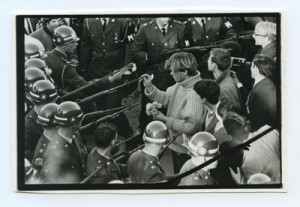 On October 21, 1967 – Bernie Boston’s photo of the brave, peace-loving teenager in a turtleneck sweater putting flowers into the gun barrels of military police went far beyond being a runner up for the Pulitzer Prize. This iconic moment became the origin of “Flower Power,” the most popular anti-war catchphrase of the 1960s. Mr. Boston told Alice Ashe of Curio magazine in 2005, “I saw the troops march down into the sea of people, and I was ready for it. One soldier lost his rifle. Another lost his helmet. The rest had their guns pointed out into the crowd, when all of a sudden a young hippie stepped out in front of the action with a bunch of flowers in his left hand. With his right hand he began placing the flowers into the barrels of the soldiers’ guns. ‘He came out of nowhere,’ says Boston, ‘and it took me years to find out who he was . . . his name was Harris.'”
On October 21, 1967 – Bernie Boston’s photo of the brave, peace-loving teenager in a turtleneck sweater putting flowers into the gun barrels of military police went far beyond being a runner up for the Pulitzer Prize. This iconic moment became the origin of “Flower Power,” the most popular anti-war catchphrase of the 1960s. Mr. Boston told Alice Ashe of Curio magazine in 2005, “I saw the troops march down into the sea of people, and I was ready for it. One soldier lost his rifle. Another lost his helmet. The rest had their guns pointed out into the crowd, when all of a sudden a young hippie stepped out in front of the action with a bunch of flowers in his left hand. With his right hand he began placing the flowers into the barrels of the soldiers’ guns. ‘He came out of nowhere,’ says Boston, ‘and it took me years to find out who he was . . . his name was Harris.'”
“Harris” was George Harris III, at 18 years of age, whose life’s work was an example of Flower Power and free expression. George went on to rename himself “Hibiscus” and created powerful new forms of theater and political expression around the world. He passed away from AIDS in 1982 at the age of 32. His life story is recounted in ‘Caravan to Oz: a family reinvents itself off-off-Broadway,’ a memoir written by his family. www.caravantooz.com

